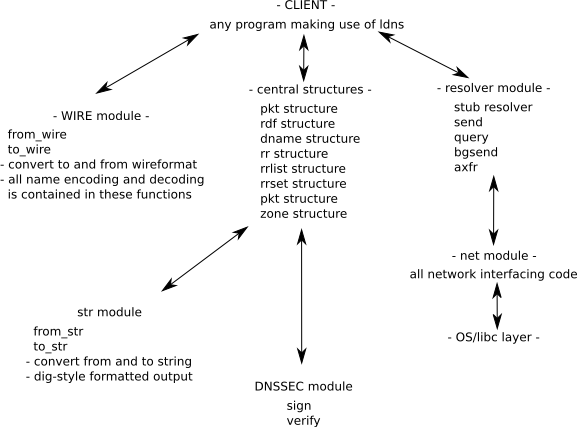The following image shows the various modules of libdns and their functionality.

Central structures
- ldns_pkt A DNS Packet, which can contain a query, answers, and additional information.
- ldns_rr A Resource Record, which holds a bit of information about a specific domain name.
- ldns_rdf An RDATA field, every Resource Record contains one or more RDATA fields, depending on the type of RR. These are the 'basic types' of DNS data.
- ldns_rr_list A list of resource records
- ldns_zone A representation of a DNS Zone.
The actual structure definitions are named ldns_struct_<name> which are all typedeffed to ldns_<name>
A DNS Resource record looks like this:
nlnetlabs.nl. 600 IN MX 10 open.nlnetlabs.nl.
\ \ \ \ \ /
owner ttl class type \ rdf[] /
(rdf) (uint32_t) (rr_class) (rr_type)
10 := rdf[0]
open.nlnetlabs.nl. := rdf[1]
Owner: The owner name is put in an ldns_rdf structure, which is a normal rdata field but always has the type LDNS_RDF_TYPE_DNAME.
An ldns_rdf structure has 3 members; the size, the type of rdata and a void * pointer to the data. The data is always in uncompressed wireformat.
The RSH (rdata) is put in an array of rdf's (in this case 2).
The entire resource record is put in a RR structure, which has the fields described above (under the RR):
- owner (nlnetlabs.nl.)
- ttl (600)
- class (LDNS_RR_CLASS_IN: 'IN')
- type (LDNS_RR_TYPE_MX: 'MX')
- rd_count (2)
- rdata_fields[rd_count]
- rdf[0] (10)
- rdf[1] (open.nlnetlabs.nl.)
RR list structure: An RR list structure is simply a structure with a counter and an array of RR structures. Different kinds of RR's can be grouped together this way.
RRset structure: An RRset structure is an RR list structure, but its accessor function checks if the ldns_rr structures in there are:
- from the same type
- have the same TTL
- have the same ownername
This is the RFC definition of an RRset.
pkt structure: A pkt structure consists out of a header structure where packet specific flags are kept, TC, RD, IP from the server which sent the packet, etc. Further more it is divided in 4 sections: question, authority, answer and additional.
All four sections have the type RRlist that simply hold a list of RR's
Wire module and central structures Interface
As the WIRE module takes care of the compression/decompression it needs a buffer which holds all the binary DNS data. All functions will operate on such a buffer to extract specific information which is then stored in RR structures.
Resolver module and central structures Interface
The resolver module always returns a pkt structure. Either with the answer or a SERVFAIL pkt.
The exact function-call parameters have not yet been decided on.
Also the resolver module will need to access some of the to_wire and from_wire function to creates ldn_pkt's from the data it receives (arrow not drawn).
str module and central structures Interface
Convert to and from strings. This module could be used to read in a zone file (list of RRs) and convert the text strings to the format used by ldns. Or the other way around.
Net module and resolver module interface
The resolver module will get a packet and will mold it so that it can be sent off to a nameserver. It might need to interface with the wire module (arrow not drawn).
module and OS/libc interface
OS/network calls will be used here. The Net module is the only part of the library where the underlying OS matters.
program ldns interface
Any client program will have access to
- Wire module
- Central structures
- Resolver module
- str module (arrow not drawn in the above figure)
DNSSEC module
The DNSSEC types are handled in the RR module, but the crypto routines are contained in this module. This module will depend on OpenSSL for the crypto routines.